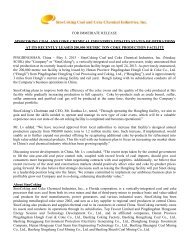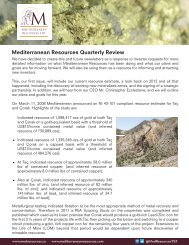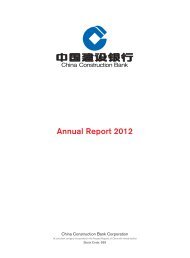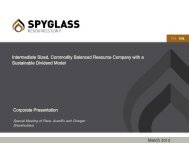Clock - Uranium Supply Crunch and Critical ... - Andrew Johns
Clock - Uranium Supply Crunch and Critical ... - Andrew Johns
Clock - Uranium Supply Crunch and Critical ... - Andrew Johns
- No tags were found...
Create successful ePaper yourself
Turn your PDF publications into a flip-book with our unique Google optimized e-Paper software.
<strong>Uranium</strong> Canada Research | Page 5 of 87Cameco, <strong>Uranium</strong> One, <strong>and</strong> Kazatomprom have each stated their Japanese customersare continuing to take deliveries of uranium, albeit, with some deferrals. Cameco, asignificant supplier to Japan (17% of Cameco’s future sales, as of late-2011), statedJapan’s utilities continue to participate in funding for mine development <strong>and</strong>exploration, are upgrading their power plants, <strong>and</strong> have turned down offers to purchasetheir inventories – to the contrary, Cameco stated on its 1Q12 conference call that someutilities were actually looking to acquire more uranium.With these factors in mind, we are looking for the next batch of reactors in Japan to resumeoperations in early 2013E, once their stress test results have been accepted (likely a fewmonths after the establishment of the new nuclear regulator in September 2012E) <strong>and</strong> localapprovals secured. We believe uranium prices should benefit from these restarts given thereduced likelihood of inventory selling; we estimate Japanese utilities cumulatively holdone of the largest commercial uranium inventories globally, given a conservative mentalityof safeguarding against supply disruptions, coupled with the third largest reactor fleet inthe world. With future operations of reactors up in the air, this material has beensomewhat of an overhang in the market as, according to UxC <strong>and</strong> others, many buyerswere holding off on purchases to see if this uranium was going to become available.Restarts could remove the overhang, supporting prices in the near-term.Further out, we believe most of Japan’s reactors will start-up by 2017E. However, by thelate-2020s, nuclear’s share of Japan’s energy mix will likely settle towards 15% (low-30sGW). Our forecast reflects reports of the country’s new energy plan (Reuters, May 25,2011) <strong>and</strong> US EIA’s latest forecast for Japanese electricity generation growth(September 2011).Expiry of the Russian HEU <strong>Supply</strong> Agreement. Signed in 1993, the Russian HEUCommercial Agreement (or “Megatons to Megawatts”), is a 20-year deal to down-blend500 t of highly-enriched uranium (HEU) from Russian warheads into ~400 Mlbs U3O8-equivalent for use in reactors in the US <strong>and</strong> Europe. This deal ends in December 2013E<strong>and</strong> the Russian government has repeatedly stated it has no interest in an extension. In2011A, this HEU-derived material comprised ~13% of 2011A total global uranium supply,<strong>and</strong> was heavily relied upon to bridge the gap between mine supply (~138 Mlbs) <strong>and</strong>total dem<strong>and</strong> (~184 Mlbs). Once the deal ends, utilities will have to look at moretraditional sources (e.g. long-term contracts with producers or the spot market) to shoreup their future needs, which should put upward pressure on prices. We expect a marketresponse in advance of expiry of the agreement, which is scheduled for year-end 2013.SeasonalityHistorically, the annual World Nuclear Association (WNA) Symposium has been viewedas the kick-off to the uranium contracting season <strong>and</strong> often correlates with an uptick inuranium transaction volumes <strong>and</strong> prices, following the softer summer ‘doldrums’ (seeExhibit 4). This year’s conference will be held September 12 – 14 in London, UK.Exhibit 4: Monthly Average Spot Price Changes (Jan-02-current; absolute terms, US$)$3.0$2.0$1.0$0.0-$1.0-$2.0-$3.00.1-0.10.21.01.70.9-0.7-0.6-2.5Jan Feb Mar Apr May Jun Jul Aug Sep Oct Nov DecSource: Raymond James Ltd., UxC0.72.50.7These restarts should benefituranium prices in the near-term,by reducing the perceivedlikelihood of Japanese inventorysellingWe expect most Japanese reactorsback online by 2017EThe Russian HEU Agreement, 13%of global supply in 2011A, ends in2013 – utilities will have to relymore heavily on traditionalsources to meet their needs<strong>Uranium</strong> prices have historicallyrallied in the fallRaymond James Ltd. | 2200 – 925 West Georgia Street | Vancouver BC Canada V6C 3L2
















